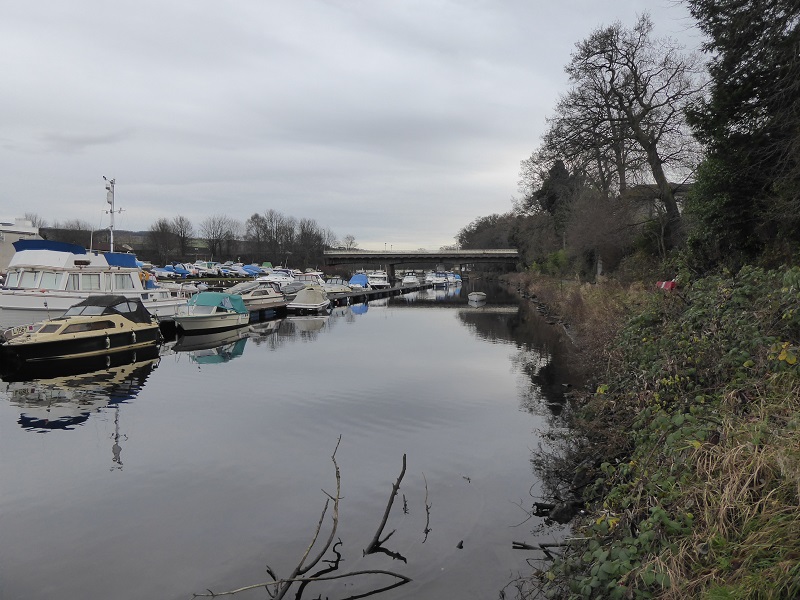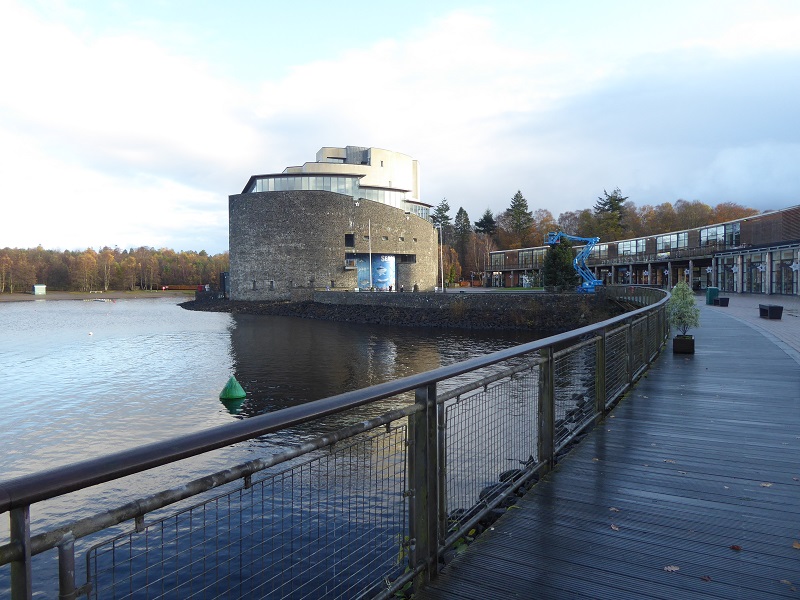
[Editor’s note: my apologies to James and readers, I had intended to appear publish James’ objection to the Flamingo Land proposal at the end of June. It makes a forceful case for nature]
My objection to the Flamingo Land planning application was as follows.
To the east, the Site Boundary is on the River Leven
Following 20 years of National Park/Interim Committee incompetence and neglect the River Leven remains a site of industrial dereliction between The Loch and the River Leven Barrage…the National Park Boundary. Indeed, the extent of industrial dereliction has been greatly increased due to NP planning permissions for large metal pontoon moorings anchored into the river bed. The river has been converted into a boatyard for hundreds of boats. No natural habitat restoration, improvement or conservation is possible under these conditions.
Due to 20 years of National Park/Interim Committee incompetence and neglect the R. Leven is also used as an open sewer……within the NP. Downstream the local communities have often complained, to no avail, about the pollution from Balloch, such as oil spills, human excrement, fly tipped rubbish and junk.
During periods when the Barrage is closed and water flows are reduced, huge volumes of pollutants accumulate upstream of the Barrage. When the Barrage is opened and water flows increase these mountains of pollution are swept down the R. Leven and from there into the River. Clyde – and eventually come to rest on the shores at Bowling, Dumbarton, Cardross and Helensburgh where it is removed by litter pickers time and time again.
On one occasion it took 3 days for the R. Leven to clear. On average, it takes between 1 and 2 days to clear. Every year thousands of tons of oil, human excrement and fly tipped rubbish and junk are disposed of in this way.
Of course, for the business studies students, this has it’s economic advantages – the R. Leven open sewer/refuse disposal facility operates free of charge and that allows our creative polluters to minimise their costs and maximise their profits. What could possibly go wrong?
The main natural heritage interest on the River Leven is the Atlantic Salmon. This is a key indicator species…if the salmon are doing well that is good news for all of the other aquatic flora and fauna and their habitats. The R. Leven provides spawning habitat and it is the only migration route for returning adults and juveniles travelling back and forth between freshwater and the sea. The conservation of Atlantic Salmon is covered by the Endrick Water SAC Management Plan which includes the R. Leven.
Following 20 years of National Park/Interim Committee incompetence and neglect nothing has come of this plan in terms of Atlantic Salmon habitat restoration, improvement and conservation on the R. Leven. Indeed, over the last 20 years they have presided over the inexorable decline in Atlantic Salmon populations and we are now in the midst of a probable extinction event.
The Flamingo Land development can only represent a huge increase in the risks and threats to Atlantic Salmon and Atlantic Salmon habitat in this context. Combined with the National Park/Interim Committee’s 20 year record of incompetence, neglect and failure the survival of Atlantic Salmon here is seriously endangered.
To the west, we have a large car park, a shopping centre and an indoors plastic tank, non-native species, clown fish aquarium.

Natural habitat destruction and losses are total – except for the almost extinct powan and their spawning grounds in Drumkinnon Bay. In response to the business studies students and the “economic benefits” which are said to accrue to local communities, in support of these developments, it’s worth adding that Blackstone Private Equity still holds a controlling interest in Merlin Entertainments/the aquarium… last time I checked. These “Locusts on The Loch” form the largest debt fuelled real estate company in the world. They do not live here. It is important to notice where profit is created and where it is realised. In this case, it is created here and it is realised by others outside of this area and elsewhere. They take the lions share, we receive the birdseed. Lessons need to be learned about big business and transnational global corporations. They have zero loyalty to the local communities and the labour they exploit.
The Flamingo Land proposal, as such, represents a very large example of industrial factory production for the mass market. Nothing could be more alien or further removed from the FIRST AIM of the National Park “to conserve and enhance the natural and cultural heritage of the area”.
I gather there is a problem with the capacity of the sewers. To “solve this problem” before, Scottish Water installed numerous combined sewer outflows on the R. Leven. When the system reaches it’s capacity raw untreated sewage escapes and flows directly into the R. Leven. You get the picture…any waste oil, human excrement, fly tipped rubbish and junk…just chuck it into the R. Leven. That always gets a “thumbs up” from the NP.
2019 is THE INTERNATIONAL YEAR OF THE SALMON. Following 20 years of National Park/Interim Committee dereliction, incompetence, neglect and failure it is a 100% guaranteed certainty the NP will not be receiving any prizes for best practice in that event. They have been the salmon’s worst nightmare.
Now you can ignore what I just said, change the subject and talk about me. That’s something else you have been doing the last 20 years. You don’t want to lose your record.
Challenge the National Park to dispute this informative article essentially line by line. This area belongs to all the people of Scotland and yhis article cannot be ignored and dismissed. The Scottish Government will need to Call In the Planning Application.
Indeed. No argument from me.
Thanks Nick. I forgot something as well. I took part in probably all of the consultations and meetings, never mind personal communications, for the Loch Lomond Catchment Management Plan and the River Basin Management Plans, between 1999-2009. The River Leven was designated as SEVERELY MODIFIED under the River Basin Management Plans. So, that has been officially acknowledged. On the scientific information front my biggest problem has been The Loch. That is a magnet for everyone and not just tourists etc. I checked with Pete Murray of SEPA at the time and he confirmed 90% of SEPA’s work was on the Loch. As a consequence, there has always been a severe lack of scientific data available for the River Leven. I think the planners and developers would like to keep it that way because that makes it impossible to measure wither the impacts of developments are significant or not. According to EU law the burden of proof is on the developer…but a consultant’s Environmental Report will cover that insofar as the planners are concerned. Dr Burrows, the former fisheries scientist at the Loch Lomond Fisheries Trust agreed with me….these Environmental Reports are not worth the paper they are printed on.
An intriguing article on the perilous environmental state of the River Leven and the impact the proposed Flamingo Land development would have. There are many parallels with issues in the Cairngorms National Park – e.g.:
– the proposal for a new town (An Camus Mor) near Aviemore to be sited in a regenerating area of forest
– the focus on the aim of economic development at the cost of the main aim of conserving and enhancing natural and cultural heritage.
– SEPA and Scottish Water turning a blind eye to water pollution issues
– dubiously funded companies operating key facilities – in the Cairngorms case it is Natural Retreats operating Cairngorm Mountain
I relate to James’ concern as to whether anyone is listening – in particular the National Park Authorities and the Scottish Government. Unfortunately these issues extend well beyond our National Parks. It’s worth reading what the Chief Executive of NTS is saying – see https://www.nts.org.uk/stories/building-a-planning-system-that-works-for-everyone.
I’ve seen the raw sewage being drained into the Leven below the main bridge in Balloch. I was in disbelief that this is still allowed and legal.
Ed. That’s right. There’s a combined sewer outflow just downstream of the barrage. It was on the front page of The Lennox Herald one year and I raised that with the NP Fish and Fisheries Forum at the time. Likely it’s still in my files. It wasn’t working the way it’s supposed to work though. It’s an escape valve that should only release effluent into the river when the system reaches it’s full capacity. I don’t know. Maybe there was a blockage somewhere.
I don’t think it’s happened on the Leven yet, but the worry is a big fish kill like they’ve had on the Clyde at Glasgow. These outflows are huge breeding grounds for bacteria and after a dry spell the sludge becomes concentrated. If you then get a sudden heavy downpour that flushes this soup into the river and it strips all of the oxygen out of the water. Adult salmon are the most vulnerable because they have a greater oxygen demand than juvenile fish. It’s happened a few times on the Clyde with hundreds of dead salmon seen floating to the surface, lining the banks and being washed downstream. WDC bragged about how it was an “environmental improvement.” They even put a notice up to tell everyone what a great job they were doing.
I used to be a member of the Tweed Foundation. Nothing that happens on the Leven would be accepted on the Tweed. They would be strung up and kicked out of town.